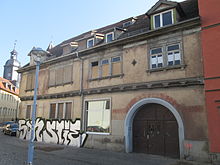Bruehl (Gotha)
Brühl describes a historic street in the old town of Gotha in Thuringia .
History and cityscape
The road was first mentioned in 1482. Brühl (from Middle Latin brogilus or broilus : piece of tree) means "damp valley". Brühl is the name of many low-lying parts of the city, some of which are covered with trees, and streets that may have been built on former marshland, including the Gothaer Brühl. Here was the Holy Cross Gate, later renamed the Brühler Tor.
The relatively narrow, multi-winding road is the result of a long settlement development. In their place, in the middle of the east side of the ludowingische Landgraf was the 12th century, the "Old Market" of the city Gotha, Louis IV. And his wife Elizabeth in 1223, the surviving Mary Magdalene Hospital donated. The street is thus one of the oldest streets in the city and differs in its layout, its multiple curved course and its narrowness clearly from the other, mostly straight streets of Gotha's old town, which was expanded according to plan in the later 13th century and walled 1210–1253 . In the later Middle Ages and early modern times it led from the main market through the former Brühler Tor , to the country roads as part of the Via Regia to Eisenach in the west and to Goldbach in the north. Today the street is designed as a pedestrian zone and ends in the northwest at the busy Bertha-von-Suttner-Platz.
Before the demolition - apart from a vacant lot - the streetscape was almost completely shaped by historical buildings from the Renaissance , Baroque , Wilhelminian and Art Nouveau periods .
House Brühl 9–11 was dated to 1525 in 2010 by a dendrochronological report by the building historian Udo Hopf and was therefore the oldest known half-timbered house in the city of Gotha. It is said to have originally stood in front of the Brühler Tor and served as a soup kitchen. When the city was re-fortified after the Schmalkaldic War , it was moved to its current location in 1542. There it served as a residential building. At the latest since 1990 it was owned by the city of Gotha and served the customs and until 1993 as the seat of the SPD district association. The refurbishment of the house, which had been vacant for over 20 years, was controversial; the house was finally demolished in May and June 2014. The house Brühl 13-15 was an eaves-standing Renaissance building with a lateral passage in the stone ground floor and a cantilevered half-timbered storey above. The sleepers and fillers were typical of the time and a. decorated with ship throats. In 2009 the property was acquired by the city of Gotha and demolished in 2014.
Monument protection
The street Brühl was already shown as an ensemble in the list of monuments of the Gotha district council of September 1st, 1988 . The buildings Brühl 2, Brühl 4 ( Maria Magdalena Hospital ), Brühl 5 (Brühl drug store), Brühl 7 (King's Hall, as King Gustav II Adolf of Sweden is said to have stayed here once) and Brühl 15 reported. During the preparatory studies for the renovation of the old town in 1991, the buildings Brühl 11, Brühl 19 and Brühl 21 were suggested as additional individual monuments.
In the revised list of monuments from 2009 , the street is part of the old town of Gotha, which is protected as a whole according to § 2 Paragraph (2) No. 1 ThürDSchG . In addition to the Maria Magdalena Hospital, only the residential and commercial buildings Brühl 5, Brühl 7 and Brühl 19 are listed as individual monuments.
demolition
In November 2013, the city of Gotha presented plans according to which buildings 9, 11, 13 and 15, which had been vacant since the 1990s and which the city had acquired from the previous owners, should be demolished and replaced by a modern residential complex with 29 apartments . The city's own construction company Gotha (BGG) was commissioned with the implementation . The demolition began in April 2014, despite public protests.
See also
swell
- Beck, August : History of the City of Gotha, Gotha 1870
- Planning office Thuringia: Old town renovation Gotha, report on the preparatory investigations , Gotha 1991
- Uhlig, Lotar: Development and Structure of the City of Gotha , Geographical Reports 115, issue 2/1985
- Dehio, Georg (ed.) : Handbook of German Art Monuments, Thuringia , edit. by Stephanie Eißing, Munich-Berlin 1998
Web links
- Housing cooperative Gotha, March 2013
- Facebook: Anno 1525 - Gotha's oldest house is about to be demolished
Individual evidence
- ^ Hans Walther: Street Chronicle of the City of Gotha , ISBN 3-934748-26-0
- ^ Müller, Christine: Landgrave cities in Thuringia. The city politics of the Ludowingians in the 12th and 13th centuries. Weimar 2003. (Publication by the Historical Commission for Thuringia. Small series, Vol. 7). Pp. 248-255. Sources not clarified. Compare Heß, Heinrich and Schmidt-Ewald, Walter: Gotha in the Middle Ages, p. 98. In: Schmidt, Kurt: Gotha-The book of a German city. Vol. 2. Gotha 1927.
- ^ Hopf, Udo: The old Sundhauser Gate in Gotha [working title]. In: Archeology in Germany 6/2011. Stuttgart 2011.
- ↑ Lotar Uhlig: Development and Structure of the City of Gotha, Geographical Reports 115, issue 2/1985, p. 83
- ↑ Michael Keller: The oldest known house in Gotha is irredeemably lost. Thuringian General Gotha , February 20, 2014
- ↑ Birgit Schellbach: Demolition of the oldest semi-detached house in Gotha has begun , Thüringer Allgemeine Gotha, May 27, 2014
- ↑ Axel Eger: Barrier-free apartments are being built in Brühl in Gotha, Thüringer Allgemeine Gotha, November 28, 2013
Coordinates: 50 ° 57 ′ 2 " N , 10 ° 41 ′ 59" E






